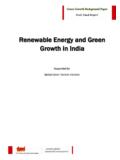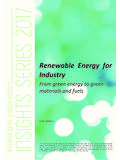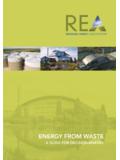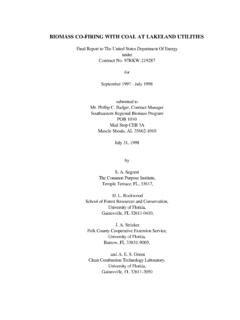Transcription of Fossil Fuel to Renewable Energy - UNOSD
1 Fossil fuel to Renewable Energy Comparator Study of Subsidy Reforms and Energy Transitions in African and Indian Ocean Island States United Nations Office for Sustainable Development Jacqueline Cottrell, Fran ois Fortier and Kai Schlegelmilch 2 Report summary Energy is key to prosperity, and the discovery and use of Fossil fuels in the past few centuries has generated tremendous wealth. Yet, this Energy paradigm has now become a liability that threatens the very sustainability of all it enabled. Coal, petroleum and gas not only induce climate instability through emissions of greenhouse gases, but also entail numerous other economic, social and environmental externalities, adding up to a dangerously negative balance sheet. This report analyses the impacts of Fossil fuel Energy in the multiple dimensions of sustainability, model-ling the relationships, externalities, and opportunities that a transition to a new Energy paradigm can offer, based on Energy conservation, efficiency and low-carbon Renewable sources.
2 It first explores the sustainability doughnut as an integrative model, which facilitates the overlaying of policy choices, including Energy -related ones, with the economic, social and environmental sustainability impacts they have. This provides a cogent framework for the comparison of the Fossil fuel and Renewable Energy paradigms, highlighting their costs and opportunities. Based on this modelling and rationale, the bulk of the report then turns to analysing Fossil fuel subsidy reforms and Renewable Energy (RE) transitions in the context of island states, with particular reference to Small Island Developing States (SIDS) in the Indian Ocean and Atlantic African coast. With policy-relevance as key objective, the report makes a series of general and country-specific recommendations, underlining the most important policy areas of Fossil fuel to Renewable Energy (FFRE) transition in the island states that participated in a capacity building workshop organised in Mauritius, in May 2014, by UNOSD and the Maurice Ile Durable These recommendations have broader policy relevance for countries wishing to pursue a Fossil fuel subsidy reform and Renewable Energy transition.
3 Main conclusions There is increasing focus and innovation in island states on Renewable Energy , and for Energy transitions along the post-2015 development agenda (AIMS2 SIDS, 1 Workshop information at page=view&type=13&nr=22&menu=229 (accessed 01/07/2014). 2 Atlantic, Indian Ocean, Mediterranean and South China Sea. 2013). Many island states have drafted or adopted national and regional Energy policies and strategies seeking to improve Energy efficiency and exploit Renewable Energy potential, notably to minimise future dependence on imported Fossil fuels (UNEP, UNDESA and FAO, 2012). To ensure the success of Fossil fuel to Renewable Energy transitions however, key measures need to be followed-up and implement-ed with determination, and as soon as possible.
4 Given that most island states have market economies, prices are crucial for investment and consumption decisions. Influencing prices via taxes and subsidies provide strong leverages for governments to change behaviour and reduce Fossil fuel consumption. Moral appeals, information campaigns and awareness-raising may be important, too, but often not as effective as price signals, a key factor in household and industrial decision-making. The challenge for island states today is to identify how best they can benefit from the falling price of Renewable Energy , as soon and as much as possible. Fiscal space and EFR To create an economic climate which fosters FFRE transitions, island states need to adjust Energy pricing to match their national context by means of environmental fiscal reform (EFR).
5 Increased domestic revenue mobilisation through environmental tax-ation and subsidy reform can promote the FFRE agenda by increasing fiscal space and delivering much-needed revenues to meet critical spending needs. Island states should also consider regionally coordinating and harmonising fiscal policies in the tourism and aviation sectors. This could include a standardised levy per overnight stay or an infrastructure service charge paid on entry or exit. While unilateral measures may encounter political resistance among industry stakeholders, coordination between major destinations, in the Indian Ocean basin, will partly address concerns, and avoid a race to the bottom in the tax treatment of the two sectors. Along with such reforms, regular reviews of the fiscal system should be institutionalised to monitor and report on government revenues and expenditures.
6 Impact assessments can then inform adjustments, particularly in protecting the vulnerable. Consistent communication strategies on the rationale and benefits of reforms will also help gain further acceptance. 3 Mobilising investment Creating a stable investment climate is essential to facilitate a FFRE transition. Policy measures should take the multi-faceted nature of Energy markets into consideration and provide for: Making mobilisation of private investment a political priority Support capacity development with institution building ( nurturing relevant trade associations) and training of human resources ( specialised RE skills) Ensuring a good return on investment by means of feed-in tariffs (FITs) and appropriate power purchase agreements (PPAs)
7 Facilitating access to RE solutions by fostering technology transfer and removing import duties on RE technologies and components Consider aggregating FFRE projects to develop new models of ownership between islands, taking advantage of economies of scale in the RE sector and reduce the cost of RE transition in each individual island state Reducing investment risk by making contracts clear and transparent, providing infrastructure and loan guarantees to instil investor confidence Creating a level-playing field in Energy markets through a Fossil fuel subsidy reform and green taxation, including varied customs and duties on Fossil fuels and RE technologies and components Introducing technical and integrated resource planning Policy mainstreaming and FFRE transition roadmaps FFRE transition should be mainstreamed within all national policy planning processes, becoming part and parcel of national decision-making.
8 In supporting this integration, planning authorities need to conduct RE resource mapping and feasibility studies, exploration of policy options, and accurate modelling and cost-benefit analysis of FFRE transition impacts. Beyond this macroeconomic review, a political economy analysis must also be undertaken, mapping the stakeholders of the Energy landscape with their interests, strategies, resources, relations and discourses. Together, such comprehensive groundwork will enable a FFRE transition strategy based on realistic and sustainable assumptions, aimed at relevant objectives and guided by a clear roadmap of specific, measurable, achievable, relevant and time-bound (SMART) indicators. It will also ensure that the politics of transition is well understood and planned for, nurturing a collaborative and participatory policy process that increases the chance of success and minimises disruption.
9 Further to such groundwork, the role of policy-makers in demonstrating the value of an RE transition is crucial. Low-hanging fruits solution should be identified, such as simple Energy efficiency measures and high-return RE pilot projects that will reduce Fossil fuel dependence, improve fiscal and trade balances, and quickly demonstrate the viability of the RE transition. Acceptance of RE policies and willingness to invest will increase, making subsequent steps easier. Overcoming barriers to reform The need for reliable base-load electrical supply has raised doubts on the feasibility of high levels of RE in the Energy mix, particularly in small and unconnected island markets. These concerns are largely unfounded. Intermittence can be overcome through enhanced Energy efficiency that reduces base-load demand, along with new grid management and storage technologies that buffer both various power sources and peak demand.
10 Another area of concern has been the recent falling prices of Fossil fuels, perceived as a threat to Renewable Energy value and viability. Falling Fossil fuel prices can favour FFRE transitions in several ways, however. For one, low fuel prices create a political opportunity to reform subsidies, even eliminating them altogether, without public resistance as recently seen in Indonesia. Low prices also create opportunities for policy-makers to internalise Fossil fuel externalities by introducing new taxes to keep prices stable similarly, without public resistance. Such measures increase national fiscal space, while levelling playing fields in Energy markets, and incentivising investment in efficiency and renewables. Finally, currently low Fossil fuel prices result from overproduction, fracking and sluggish demand.







